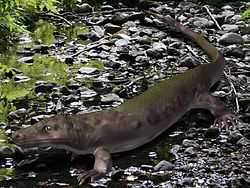Orobates
| Orobates | |
|---|---|
 | |
| Scientific classification | |
| Kingdom: | Animalia |
| Phylum: | Chordata |
| Superclass: | Tetrapoda |
| Superorder: | Reptiliomorpha |
| Order: | Diadectomorpha |
| Family: | Diadectidae |
| Genus: | Orobates |
| Species: | O. pabsti |
Orobates is an extinct genus of diadectid. It lived in the middle Permian, about 260 million years ago. Its remains were found in Germany.[1]
A combination of primitive and derived traits makes Orobates the sister group of all Diadectidae, the most primitive known member of the family of generally large bodies herbovorious reptil like amphibians. It appears to have been part of an uppland fauna, browsing on high fibre plants.[1] The trace fossil species Ichniotherium sphaerodactylum, from Bromacker in Germany has been attributed to Orobates, showing dragmarks from the tail.[2] The genus was characterized by a long body and tail, with fairly short legs and a short skull compared to the more derived Diadectes. This indicate Oreobates was less specialised for long treks compared to Diadectes.[2]
References
- ↑ 1.0 1.1 Berman, D. Berman, D. S, Henrici, AC, Kissel, R., Sumida, SS, and Martens, T. S, Henrici, AC, Kissel, R., Sumida, SS, and Martens, T. (2004): A new diadectid (Diadectomorpha), Orobates pabsti, from the Early Permian of Central Germany. Bulletin of the Carnegie Museum of Natural History No 35: pp 1-37. abstract
- ↑ 2.0 2.1 Voigt, S.; Berman, D.S.; Henrici, A.C. (2007). "First well-established track-trackmaker association of Paleozoic tetrapods based on Ichniotherium trackways and diadectid skeletons from the Lower Permian of Germany". Journal of Vertebrate Paleontology 27 (3): 553–570. doi:10.1671/0272-4634(2007)27[553:FWTAOP]2.0.CO;2.